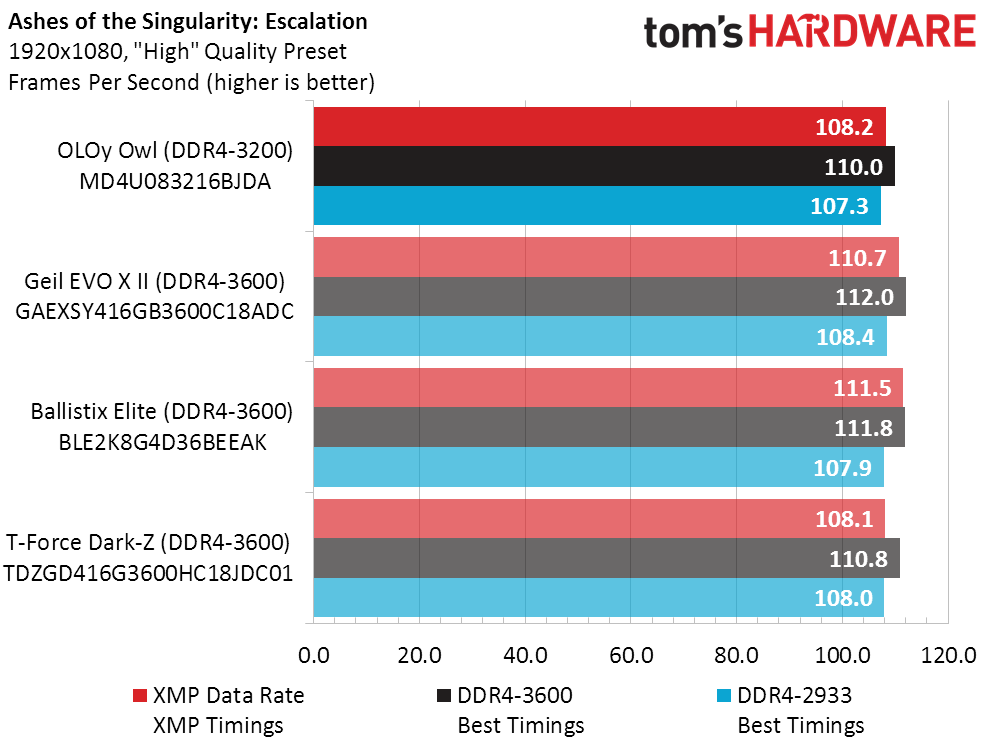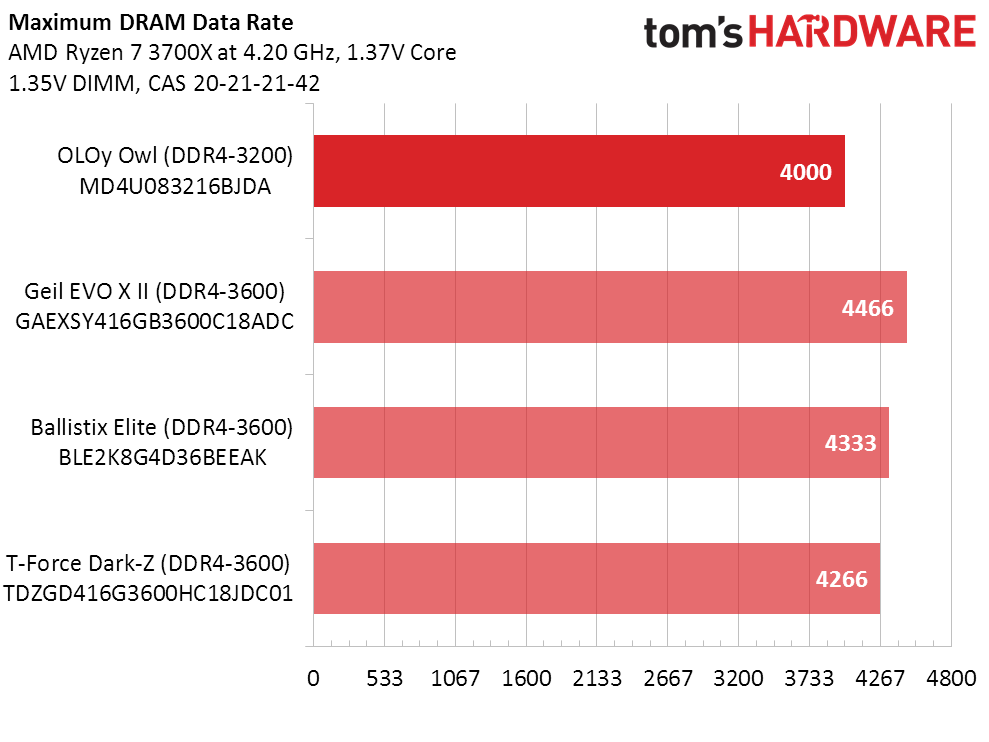Tom's Hardware Verdict
This kit could have won us over during holiday discounts. But current pricing is too similar to competing brands to set OLOy’s Owl DDR4-3200 C16 apart.
Pros
- +
Good overclocking (for DDR4-3200)
- +
Same components as better-known brands
Cons
- -
No competitive advantage in DDR4-3200 C16 market
Why you can trust Tom's Hardware
OLOy earned a fair bit of attention last year by hitting Newegg with a full range of low-cost PC memory, eventually reaching $99 for 32GB before delivering a slightly more-expensive RGB version to us for review. Intrigued by the novelty of a new brand offering hyper-competitive prices, we briefly investigated the firm’s history and warranty policy. Apart from our reservations over sending any defective modules back to Taiwan after the first three years of warranty have lapsed (and waiting for replacement modules to return) the memory you get from OLOy is like that of most other Taiwan-manufactured brands, right down to the ICs and circuit board suppliers.
People who don’t want to pay for the 32GB of capacity of that holiday-special kit can now find a 16GB version at Newegg -- though at $72, it’s around $7 more than half of that former value leader’s newly increased price. This isn’t even the cheapest 16GB DDR4-3200 C16 kit currently available through Newegg, though the kits that get those honors sell for only $3 less.
Unlike it’s higher-priced versions, OLOy Owl uses a basic SK Hynix DDR4-2133 SPD that typically indicates its ICs (chips) are rated as the same. Enabling XMP allows the kit to use higher DDR4-3200 settings at 16-18-18-36 timings, and is kept stable using the classic overclocking technique of raising its voltage to 1.35V. Motherboards that don’t have XMP or don’t support DDR4-3200 are stuck at the slower SPD, unless you know how to overclock manually.
Comparison Hardware
| Header Cell - Column 0 | OLOy Owl MD4U083216BJDA | Geil EVO X II GAEXSY416GB3600C18ADC | Ballistix Elite BLE2K8G4D36BEEAK | T-Force Dark-Z TDZGD416G3600HC18JDC01 |
|---|---|---|---|---|
| Capacity | 16 GB (2x 8GB) | 16 GB (2x 8GB) | 16 GB (2x 8GB) | 16 GB (2x 8GB) |
| Data Rate | DDR4-3200 (XMP) | DDR4-3600 (XMP) | DDR4-3600 (XMP) | DDR4-3600 (XMP) |
| Primary Timings | 16-18-18-36 (2T) | 18-20-20-40 (2T) | 16-18-18-38 (2T) | 18-22-22-42 (2T) |
| Voltage | 1.35 Volts | 1.35 Volts | 1.35 Volts | 1.35 Volts |
| Warranty | Lifetime | Lifetime | Lifetime | Lifetime |
Though a fair comparison might only include competing DDR4-3200 kits, our most recent comparison kits have all been rated at DDR4-3600. OLOy intends to make up for any performance difference with its lower price to prove itself a value giant, and we can’t fault that strategy.
Our test setup combines MSI’s MEG X570 Ace with the superb memory stability of AMD’s Ryzen 7 3700X, pulling data from Toshiba’s OCZ RD400 SSD before spitting out the results to Gigabyte’s high-flying GeForce RTX 2070 Gaming OC 8G.
Overclocking and Latency Tuning
While we shouldn’t expect every DDR4-3200 kit to reach similar maximum data rates to DDR4-3600 rivals, we have been a little spoiled by the overclocking eagerness of our two-year-old Hynix-based DDR4-2933. Inflated hopes aside, the less-eager Hynix of OLOy’s Owl still got us to a solid DDR4-4000.
Lowest Stable Timings at 1.35V (Max) on MEG X570 ACE (BIOS 1.20)
| Header Cell - Column 0 | OLOy Owl MD4U083216BJDA | Geil EVO X II GAEXSY416GB3600C18ADC | Ballistix Elite BLE2K8G4D36BEEAK | T-Force Dark-Z TDZGD416G3600HC18JDC01 |
|---|---|---|---|---|
| DDR4-4266 | X | 19-19-19-38 (1T) | 18-19-19-38 (2T) | 20-21-21-42 (2T) |
| DDR4-3600 | 16-19-19-38 (2T) | 16-17-17-34 (1T) | 16-17-17-34 (1T) | 16-18-18-36 (2T) |
| DDR4-2933 | 13-16-16-32 (1T) | 13-14-28 14- (1T) | 13-14-14-28 (1T) | 13-15-15-30 (1T) |
The lowered capability seen in overclocking repeats in latency reduction, where the DDR4-3200 Owl required more tRCD and tRP to reach DDR4-3600 and DDR4-2933. Only the faster kits were capable of DDR4-4266.
Get Tom's Hardware's best news and in-depth reviews, straight to your inbox.
Benchmark Results


The Owl’s XMP bandwidth falls noticeably behind its better-rated rivals, but tweaking it to DDR4-3600 gets it far closer to those higher-priced parts.


Perhaps the average user won’t notice a 2% difference in gaming performance when the frame rate is this high, but plenty of buyers are certainly willing to pay a little extra for that last bit of performance.


A user who’s compressing a huge file is more likely to notice a 16 second difference in completion time, but we usually move on to other tasks while these things run, only to return minutes after they’ve finished.
Final Analysis
You won’t be surprised to learn that DDR4-3200 doesn’t perform as well as DDR4-3600, but when life gives us a bit of both we can at least compare the difference in price to the difference in performance.
Value seekers will notice the big difference in price and run towards DDR4-3200, but is this the kit to get? A quick look around the web shows no remarkable difference in timings for several similarly priced DDR4-3200 kits. It’s easy for us to pick out DDR4-3200 for providing more value than DDR4-3600, but we don’t see a compelling reason to choose OLOy over other well-established brands. With its steep price advantage gone, buyers are left to pick their kit based on things like customer service and/or (shudder) heat spreader design. And while both might be “good enough” with this OLOy kit, neither is likely to stand out enough to make most users choose this model over better-known, lower-priced competition.
MORE: Best Memory
MORE: DDR DRAM FAQs And Troubleshooting Guide
MORE: All Memory Content




